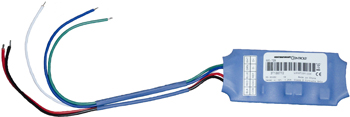Control Network Newsletter

BAS-485-TER Provides Active Termination and Fail-Safe Biasing for Modbus RTU and BACnet MS/TP EIA-485 Networks
Building management system protocols such as Modbus RTU and BACnet MS/TP utilize EIA-485 networks. This robust and popular technology for interconnecting devices on a network uses differential signaling over a twisted pair cable. Significant data rates (up to 115.2 kbps) and long cable lengths (> 1000 meters) can be supported. However, reliable back-and-forth data transmission requires attention to some key issues.
 The BAS-485-TER is a standalone active terminator. It addresses two aspects of EIA-485 networks that must be considered in order to obtain reliable operation:
The BAS-485-TER is a standalone active terminator. It addresses two aspects of EIA-485 networks that must be considered in order to obtain reliable operation:
- TERMINATION
The EIA-485 specification recommends that the "characteristic resistance" of the cabling be 120 ohms. Because of the high frequencies and distances involved, proper attention must be paid to transmission-line effects. While a thorough discussion is beyond the scope of this newsletter, suffice it to say that terminating a data cable with a value equal to its characteristic impedance reduces signal reflections that cause data errors. The BAS-485-TER features an equivalent 120-ohm resistance applied between the data lines which matches twisted-pair cable impedances as low as 100 ohms and dampens internal reflections. - FAIL-SAFE BIAS
EIA-485 drivers use three-state logic, allowing individual transmitters to be deactivated. This allows EIA-485 to implement linear bus topologies using as few as two wires. However, during "quiet" times when no devices are talking the bus will "float", enabling noise to falsely trigger a bus receiver. To ensure that the bus assumes a defined state, the BAS-485-TER sources DC power to the bus through its internal +5V electrically isolated power supply with pull-up and pull-down resistors. The use of 600-ohm resistors along with the 130-ohm terminating resistor provides a Thevenin equivalent termination resistance of approximately 120 ohms and 485 millivolts of bias. This safely exceeds the 200-millivolt region where signal levels are undefined in the EIA-485 specification.
The BAS-485-TER is a compact device that can be applied in the field quickly and easily. It comes with an isolated cover, allowing it to be installed almost anywhere. The BAS-485-TER requires 24VAC 1VA or 20-30VDC 0.5W power. Because it has an internally isolated DC to DC converter, power can be shared with the same power source used by the other devices on the network. The BAS-485-TER continues to provide a termination resistance to the network even when power is not available. The BAS-485-TER can be used with either 2-wire non-isolated EIA-485 networks or 3-wire isolated EIA-485 networks. When a head-end device does not have internal termination and bias then two BAS-485-TER should be installed—one at each end of the network.